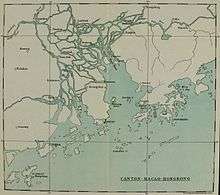Humen
| Humen | |||||||||||||
|
View of the Humen Bridge over the strait | |||||||||||||
| Traditional Chinese | 虎門 | ||||||||||||
|---|---|---|---|---|---|---|---|---|---|---|---|---|---|
| Simplified Chinese | 虎门 | ||||||||||||
| Postal | Hu-mun | ||||||||||||
| Literal meaning | The Tiger Gate | ||||||||||||
| |||||||||||||
The Humen, known historically by Europeans as the Bocca Tigris or Bogue, is a narrow strait in the Pearl River Delta that separates Shiziyang in the north and Lingdingyang in the south near Humen Town in China's Guangdong Province. It is the site of the Pearl River's discharge into the South China Sea. It contains the Port of Humen at Humen Town. The strait is formed by the islands of Chuenpi (穿鼻, p Chuanbi) and Anunghoy (阿娘鞋, p Aniangxie; also called 威远, p Weiyuan) on the eastern side, and Taikoktow (大角头, p Dajiaotou) on the western side.[1] Since 1997, the strait has been traversed by the Humen Pearl River Bridge.
Name
The Latinate Bocca Tigris is derived from the Portuguese Boca do Tigre, which is a calque of the Chinese and Cantonese name 虎門, literally meaning "The Tiger Gate".[2] The name Bogue is also a corruption of the Portuguese Boca.[2] The name comes from the hill-tops or a rock said to resemble a tiger's head on the eastern side of Tiger Island,[3][4] about 3.2 km (2.0 mi) above the Hengdang Islands in the middle of the strait.[5] American Commodore Matthew Perry, who later played a leading role in the opening of Japan to the West, noted that: "Although the resemblance is not at first very striking, it becomes quite obvious after examination".[3]
History


Because of its strategic location as the naval gateway to the city of Guangzhou (Canton), the strait was strongly fortified during the Qing dynasty. It was defended by eight forts:[6] Shakok, Taikok, Wantung, Yung-an, Kung-ku, Chen-yuan, Ching-yuan, and Wei-yuan.[7] The first major battle of the First Opium War between the United Kingdom and China occurred at the entrance of the Humen in the First Battle of Chuenpi on 3 November 1839. The British captured the Bogue forts in the Second Battle of Chuenpi on 7 January 1841 and the Battle of the Bogue on 23–26 February. The forts were recaptured on 2 April 1847 during the British Expedition to Canton. In the Second Opium War, the British recaptured the forts in the 1856 Battle of the Bogue on 12–13 November.
Geography
- Eastern shore: Humen Town in Dongguan City
- Western shore: the Nansha District of Guangzhou City
- Upper and Lower Hengdang Islands (横档岛), or North and South Wangtong Islands, in the middle of the strait
- Humen Pearl River Bridge
- Several Qing dynasty forts, including:
- Weiyuan Fort (威远炮台), near Humen Town
- Shajiao Fort (沙角炮台), in Humen Town
- Nansha Pier (新南沙客运港), in the Nansha District, 1.6 km (0.99 mi) south of the Humen Bridge
Port of Humen
The Port of Humen at Humen Town serves as the port of the industrial city of Dongguan and as one of the big logistic hubs of the Pearl River Delta. It extends on the east shore of the delta beyond the strait all the way to the Dongjiang River. It is divided into five port areas:
- Shatian Port Area (沙田港区): focuses on containers, chemicals, yard logistics, shoreline industry, and comprehensive trading services.
- Mayong Port Area (麻涌港区): focuses on grain, vegetable oil, coal, construction materials, and break-bulk cargo.
- Shajiao Port Area (沙角港区): focuses on passenger transport, leisure boating, and coastal transport and cabotage.
- Chang'an Port Area (长安港区): focuses on large-scale deep-water berths and waterfront industry.
- Neihe Port Area (内河港区): focuses on traditional waterborne transport services for the Dongguan industries.
The port has 72 km2 (28 sq mi) of territorial waters and 32 km2 (12 sq mi) of jurisdictional area. The main navigation channel is 13.5 m (44 ft) deep, enough for vessels of 100,000 DWT.[8] Originally called Taiping port, the State Council approved it as an open port in 1983. It was merged with the Shatian port in June 1997 and renamed Humen port.[9]
See also
- Treaty of the Bogue (1843)
Notes
- ↑ Bingham, J. Elliot (1843). Narrative of the Expedition to China from the Commencement of the War to Its Termination in 1842 (2nd ed.). Volume 2. London: Henry Colburn. p. 3.
- 1 2 Taylor 1898, p. 70
- 1 2 Hawks, Francis L.; Perry, Matthew (1857). Narrative of the Expedition of an American Squadron to the China Seas and Japan. New York: D. Appleton and Company. p. 161.
- ↑ Taylor 1898, p. 277
- ↑ Bernard, William Dallas; Hall, William Hutcheon (1846). The Nemesis in China (3rd ed.). London: Henry Colburn. p. 81.
- ↑ Jacobs, Thomas Jefferson (1844). Scenes, Incidents, and Adventures in the Pacific Ocean. New York: Harper & Brothers. p. 346.
- ↑ Waley, Arthur (1958). The Opium War Through Chinese Eyes. Woking, Surrey: George Allen and Unwin. ISBN 0049510126. pp. 130, 139.
- ↑ http://www.humenport.gov.cn/index/gqgk.html
- ↑ Yeung, Godfrey (2001). Foreign Investment and Socio-Economic Development: The Case of Dongguan. New York: Palgrave. p. 97. ISBN 9780333978115.
References
- Taylor, Isaac (1898). Names and Their Histories: A Handbook of Historical Geography and Topographical Nomenclature (2nd ed.). London: Rivingtons.
External links
| Wikimedia Commons has media related to Bocca Tigris. |
Coordinates: 22°47′36″N 113°35′52″E / 22.7933°N 113.5979°E
